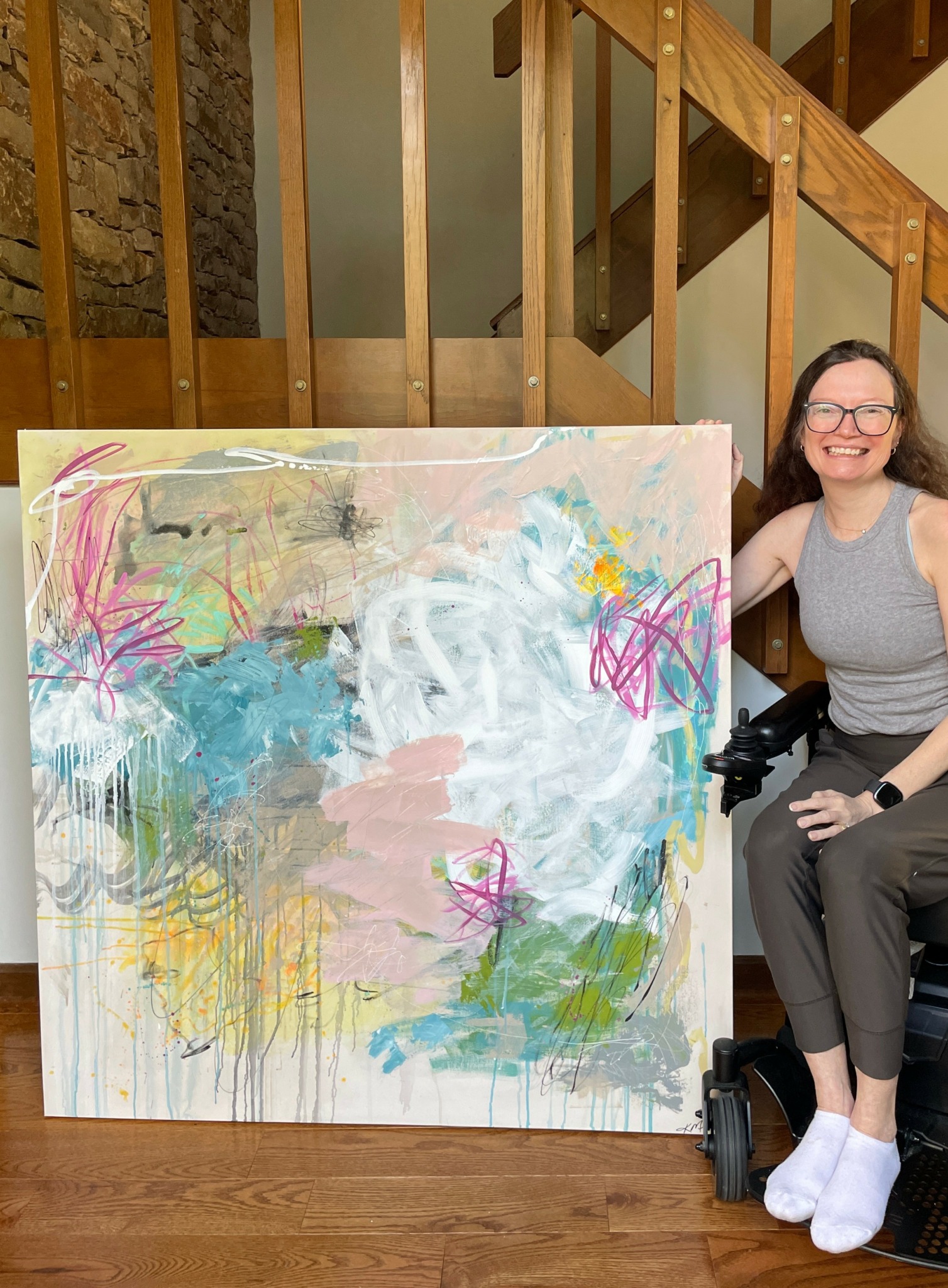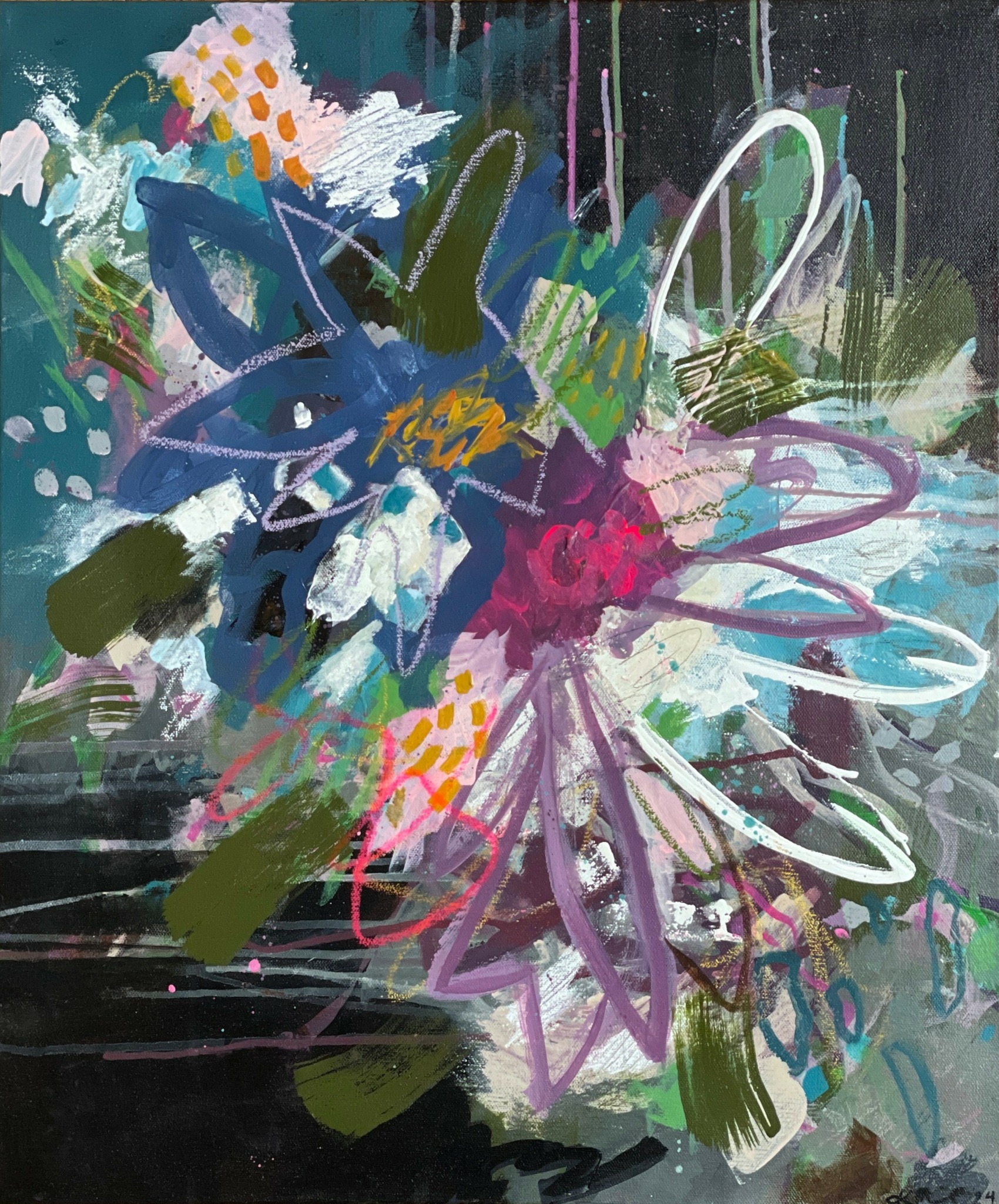We recently connected with Kelly Meiners, Phd and have shared our conversation below.
Kelly, looking forward to hearing all of your stories today. What were some of the most unexpected problems you’ve faced in your career and how did you resolve those issues?
Prior to becoming disabled by COVID in October of 2021, I was not on a creative path nor did I consider myself creative. I had successfully practiced in Kansas City as a Physical Therapist and Athletic Trainer since 1999, completed my PhD and subsequently began a career in Physical Therapy academia teaching and researching. I attained a leadership position as Chair of the Physical Therapy and Exercise Science Department at Rockhurst University in 2020. I was previously very healthy and exercised daily and ran marathons. A mild COVID infection in 2021 left me with multi organ damage and physically and cognitively disabled. I spent over a year completely bedridden, unable to talk, walk or handle basic stimulus such as light or sound. Now over 3 years later, I’m still homebound and move within my home using a power wheelchair and require a caregiver to help with day to day needs.
During my first year of Long COVID, I was in a constant state of confusion with significant impact to my short and long term memory. In my dark bedroom closet, my son found some basic acrylic painting supplies that he had used in 2020 to occupy time during the home schooling months. Even though I was unable to grasp a pencil or paintbrush, I began painting by laying on the floor and using a shower squeegee to layer paint on a canvas. The process was painstakingly slow, as one swipe of paint would trigger seizures and the recovery would wipe me out for days. Despite this, I continued painting as a way to communicate and process my loss. My first piece, “Groundhog Day” took 9 months to complete and was composed using just a shower squeegee and acrylic paint.
I soon discovered that painting offered a welcome reprieve from my suffering. Each painting was created with emotional inspiration related to my Long COVID journey. After each brushstroke (because my brain capacity would only allow a few brush strokes a week) my family would place the canvas in my bedroom. Instead of suffering in bed thinking about my illness, or overwhelmed in anguish grieving my former life, I’d instead start planning my next few brushstrokes. Painting kept me hopeful for the future and offered a therapeutic way of dealing with my profound loss.
In August 2023, 22 months after I became sick I finally improved enough to look out of a window. My light sensitivity was so severe that I lived in darkness with blackout curtains on every window. Even light from my phone or tv screen was painful and intolerable. Being able to look outside and sit on a lit room provided further inspiration for my painting. Though the stimulus from going outside was still too much on my injured brain, I would dream about venturing outdoors again.
Prior to Long COVID and my brain damage, I did not associate myself as being creative or artistic. My profession was science and memory based, very different skills than what creative people seem to naturally possess. Over the past year I’ve listened to many podcasts recorded by artists giving beginner artists recommendations on creativity. I have noticed a repetitive theme on ways to reduce creative blocks: induce boredom. I’m not sure if the hours, days, weeks, years of laying in bed without stimulus induced a creative portion of my brain to begin working or if my brain is actually functioning differently because of the damage. Regardless, I’m thankful for my newfound passion.
Because of the location of my brain injury, I have a great deal of difficulty accessing emotions and translating them to verbal expression. Painting however, allows me access to communicate complex thoughts and emotions that are otherwise inaccessible. Some of my more powerful paintings came from a place of deep despair and/or joy and hope. These feelings depicted on my painting take quite some time to accomplish, however. Painting is still quite a challenge for me nowadays because it takes so much energy to accomplish. I use large tools on my canvases while I lay down next to my works in progress and can only paint in 20 minute increments.
Since Long COVID had taken all of my previous coping mechanisms (running, lifting weights, talking to friends) painting has become an essential element in my extremely slow recovery. Art has saved my life.

Kelly, before we move on to more of these sorts of questions, can you take some time to bring our readers up to speed on you and what you do?
My painting inspiration stems from processing my grief and emotions related to becoming disabled by a new highly stigmatized and politicized illness. Frontal lobe brain damages makes accessing and processing emotions extremely difficult. As an intuitive abstract expressionist painter, I’m able to release and share these experiences and emotions on a canvas that I’m unable to articulate as both my verbal and written language is limited.
For example, most of my works from 2024 consisted of bright and energetic colors which reflected the joy I felt from being able to look out of a window after 2.5 years of severe light sensitivity and constant literal darkness. Though still unable to tolerate going outside because of other stimulation such as noise, the quality of life improvement and gratitude to viewing nature through a window was enormous.
My abstract art is primarily on canvas or paper and consists of acrylic, oil pastels, oil sticks, charcoal and various other mediums. Unable to stand or sit upright, I paint by laying on the floor next to my work. Focusing too much energy on creating also poses difficulties, I can only paint in 20 minute increments as longer sessions results in severe confusion, migraines and seizures. Though I wish to create everyday, on average I can only paint a few days each week during “good” days. Unfortunately I’m currently on month 4 of being too ill to have the energy to create and recently spend almost all day in a dark quiet bed. As I begin to stabilize health wise, I hope to begin painting again asap.
Though I started painting in 2021, I just began showing my work publicly in 2024. I’ve successfully exhibited in 2 solo shows and 14 group exhibitions this year. I’ve completed one commissioned painting and have sold several works primarily to the local Kansas City collectors but also to others I’ve connected with in places as far as London and Bogota. A huge challenge for me is being unable to personally meet others in the art community being homebound. Applications for exhibits are also difficult as my cognitive impairment limits my writing ability.
Though very limited socially, physically and cognitively, I strongly believe that our life experiences are what we make of them. I choose to look at the positive aspects of my life experiences and maintain gratitude. The only thing that we maintain control of in life is our perception of it, and I hope to portray a message of hope and possibility in my paintings. Light can be found in the darkest of places and if my works inspires just one person then I have been successful.

What do you find most rewarding about being a creative?
I initially thought the most and only rewarding aspect of being an artist is that it provides a reprieve from suffering. Because of my brain and multi organ damage caused by COVID, I feel sick and poisoned everyday. I was previously very socially engaged, worked long hours and was an active mom of 3 kids. Becoming suddenly disabled changed every aspect of my life, and thinking about all I’ve lost can be overwhelming. When I paint I forget my pain, suffering and loss and am completely immersed in the creative process. It’s a welcome reprieve especially when my future is uncertain. Very few people of my severity recover from this illness and I’ve lost several friends who have severe Long COVID like myself who have succumbed to this disease.
Another benefit that I’ve recently discovered is the impact my art has on others. Many fellow Long COVID patients have stumbled across my art and story and have reached out to me relating to a specific art piece that relates with their own experience. Especially because I am unable to attend art receptions and communicate with an audience, I often don’t see the impact that my art has on others so I’m often surprised when someone reaches out and says they are inspired by my work. It’s incredibly rewarding that something I create in the confines of my home is able to leave into the world and make a difference to someone.

Is there a particular goal or mission driving your creative journey?
Though I initially started painting as a way to communicate and grieve when I was physically unable to speak, the purpose behind my art has continued to evolve. My primary focus is still on expressionist abstract painting, however telling my story alongside my work is instrumental for advocacy work on Long COVID awareness. Though I was told by the Mayo Clinic that I’m one of the most severe cases of Long COVID they have treated, my story is still relatable to individuals suffering with a milder version of this disease. There has not been an illness so stigmatized since the AIDS epidemic and this horrible disease deserves research funds, patient support, and overall public awareness. Many studies have shown that everyone is susceptible to Long COVID and each subsequent COVID infection raises your risk. There is no cure for this disease and myself and the other many millions suffering with this deserve adequate medical treatment. I’m grateful that my art is able to raise some awareness and provides a source of hope to others battling Long COVID like myself.
Contact Info:
- Website: https://www.kellymeiners.art
- Instagram: @kellymeiners.art
- Twitter: @KellyMMeiners






Image Credits
Na


